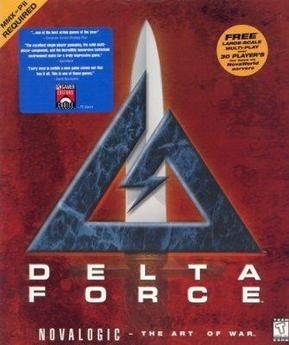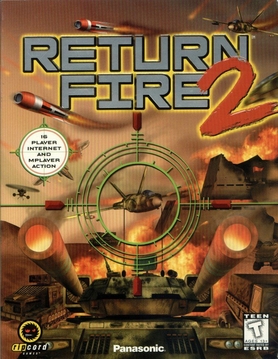
Delta Force is a tactical first-person shooter developed and published by NovaLogic. It was released for the Windows in October 1998. Delta Force was designed to be a military simulation loosely based on the United States' Delta Force special operations army unit.

Starsiege: Tribes is a first-person shooter video game. It is the first of the Tribes video game series and follows the story from Metaltech: Earthsiege and Starsiege. It was developed by Dynamix and published by Sierra On-Line in 1998. An expansion pack, Tribes Extreme, was cancelled; it was supposed to add single-player missions, multiplayer maps, and bot AI.

Shogun: Total War is a turn-based strategy and real-time tactics video game developed by The Creative Assembly and published by Electronic Arts for Microsoft Windows personal computers. Released in June 2000, the game became the debut title in The Creative Assembly's Total War series. Set in Japan during Sengoku jidai—the "Warring States" period from the 15th to the beginning of the 17th century—the game has players adopt the leader of a contemporary Japanese clan, attempt to conquer the nation and claim the position of shōgun. The turn-based aspect of the game focuses on a map of Japan where military force, religion, diplomacy, espionage and economics all influence the player's actions, whilst battles are fought in a 3D real-time mode.
NovaLogic, Inc. was an American software developer and publisher established in 1985 and based in Calabasas, California. The company was founded by CEO John A. Garcia. Garcia's background in computer software started in Southern California in the early 1980s, when he worked at Datasoft. The company was known for their Voxel Space engine, which was utilized in franchises such as the Comanche and Delta Force series. In October 2016, NovaLogic's assets were bought out by THQ Nordic who are not currently using the label.

Star Wars: Force Commander is a real-time strategy video game released for the Microsoft Windows platform in 2000. It was co-developed by Ronin Entertainment and LucasArts, and published by LucasArts. Its plot interweaves between Star Wars: A New Hope and Return of the Jedi, taking place in key battles. Peter McConnell created remixed tracks of John Williams's original score with influences from hard rock and techno music.

SWAT 3: Close Quarters Battle is a 1999 tactical first-person shooter video game developed by Sierra Northwest and published by Sierra Entertainment exclusively for Microsoft Windows. It is the seventh installment of the Police Quest series and the third installment in the SWAT subseries. Set in the then-future year of 2005, the game follows the Los Angeles Police Department (LAPD) Metropolitan Division SWAT unit as they combat a wave of violent crime and terrorism in Los Angeles in the lead-up to a nuclear disarmament treaty signing.

FIFA 2000 is a football simulation video game developed by EA Canada and published by Electronic Arts. It was the seventh game in the main FIFA series. The game was released for Microsoft Windows and PlayStation. A version for the Game Boy Color was developed by Tiertex Design Studios and published by THQ.

Hidden & Dangerous is a 1999 tactical shooter video game, developed by Illusion Softworks. It was published by Take-Two Interactive and TalonSoft, for Windows, Dreamcast and PlayStation. The PlayStation port of the game was developed by Tarantula Studios, and it is regarded as a pioneering tactical shooter. A sequel, Hidden & Dangerous 2, was released in 2003.

Interstate '82 is a vehicular combat video game developed and published by Activision for Microsoft Windows in 1999.

MechWarrior 3 is a vehicle simulation game, part of the MechWarrior series. It featured a new 3D accelerated graphics engine at the time of its release. The game contains over 20 missions, with access to 18 different mechs. A novelization called Trial Under Fire was written by Loren L. Coleman.

Star Trek: The Next Generation – Klingon Honor Guard is a 1998 first-person shooter set in the universe of Star Trek during the time of The Next Generation. The game was developed by MicroProse, using the Unreal game engine. The critical response to the title was generally positive with praise for the graphics, but mixed opinions of the level design.

Star Wars: Episode I – The Phantom Menace is a 1999 action-adventure video game developed by Big Ape Productions and published by LucasArts for Windows and the PlayStation. An adaptation of the film of the same title, players take on the role of Qui-Gon Jinn, Obi-Wan Kenobi and several other characters in a near-identical retelling of the film. Each playable character has a unique weapon and ability.

Gorky 17 is a turn-based tactics tactical role-playing video game developed by Polish studio Metropolis Software and published by Monolith Productions for Microsoft Windows in 1999. The game was later ported to Linux by Hyperion Entertainment and published by Linux Game Publishing in 2006. The AmigaOS 4 version was released in 2015.

Theme Park Inc. is a construction and management simulation video game. It is the sequel to Theme Park World (1999). Theme Park Inc. was developed by Bullfrog Productions and published by Electronic Arts. It was the last game to bear the Bullfrog logo before the company's merger with EA UK in 2004.

Shadow Watch is a 2000 Microsoft Windows video game by Red Storm Entertainment.

Return Fire 2 is a computer game developed by Silent Software and published for Windows by Ripcord Games in 1998. It is a sequel to Return Fire.

Spec Ops II: Green Berets is a tactical shooter video game developed by Zombie Studios and published by Ripcord Games exclusively for Microsoft Windows. It is the second game in the Spec Ops series. A remake was released in 2000 for the Dreamcast entitled Spec Ops II: Omega Squad.

Armored Fist 3 is a tank simulation video game developed and published by NovaLogic in 1999.

Heavy Gear II is a mecha based first-person shooter video game. Set in Dream Pod 9's Heavy Gear universe, the game was developed and published by Activision in 1999 for Microsoft Windows; it was ported to Linux in 2000 by Loki Software. It is a sequel to the 1997 video game Heavy Gear.

Invictus: In the Shadow of Olympus, also known as simply Invictus, is a video game developed by Quicksilver Software, Inc. and published by Interplay for Windows in 2000.



















